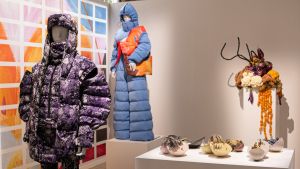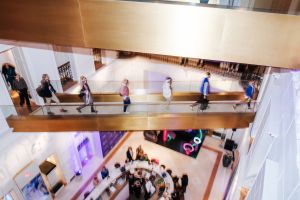Szabolcs Baranyay
ABOUT THE DESIGNER
As a glassblower, he considers the process of making glass very important, as the material is delicate and full of surprises. Being actively present during the creation of the object is as important as the preliminary design process itself. Because of the nature of glass, it is easy to make mistakes, but these mistakes often result in new objects. A good glass designer is able to recognise the potential of situations created by chance. If we look back at traditional techniques, many have been discovered in this way. But in the process, as well as recognising it, it is important to understand it, to be able to reproduce it. This is why in his work he tries to show the nature of the material, using his hands and tools to guide it rather than control it.
ABOUT THE EXHIBITED OBJECTS
Tower 1
While studying and practicing traditional glassmaking techniques, the creator came across a beautiful feature; the creation of the mouth-blown pitcher spout. Having mastered this motif, he dreamed up a group of glass objects, where he modified the technique, taking it out of its original context and function, and used it as a visual element, a lens. Additional solid lenses were added to Tower 1 to enhance the visual balance. Their placement was inspired by the world of glass bead making. He also used a technique typical of Venetian glassblowing, with the final object being assembled from a series of small elements using glue drops. The objects are both a reflection of traditional craftsmanship, paying tribute to the skills and dedication of our ancestors, and a demonstration of the organic, biomorphic nature of glass, with playful shapes and colours. The high metallic content of the colourant gives the objects a metallic sheen thanks to the reduction process.
Tower 2
While studying and practicing traditional glassmaking techniques, the creator noticed a beautiful feature; the creation of the mouth-blown pitcher spout. Having mastered this motif, he dreamed up a group of glass objects, where he modified the technique, taking it out of its original context and function, and used it as a visual element, a lens. He also used a technique typical of Venetian glassblowing, the final object being assembled from a series of small elements using drops of glue. The objects are both a reflection of traditional craftsmanship, paying tribute to the skills and dedication of our ancestors, and a demonstration of the organic, biomorphic nature of glass, with playful shapes and colours. The high metallic content of the colourant gives the objects a metallic sheen thanks to the reduction process.
CONTACT
More articles

The Hungarian Fashion & Design Agency Continues Its Operations Under the Name Creative Hungary Nonprofit Zrt.

BCEFW Young Talents Designers Featured in the Design POP-UP by ELLE Selection



